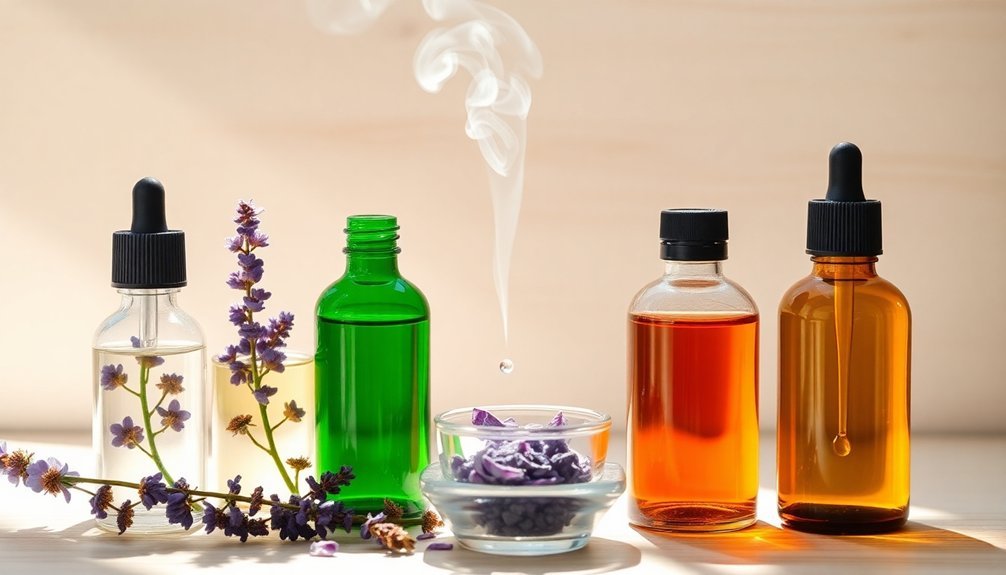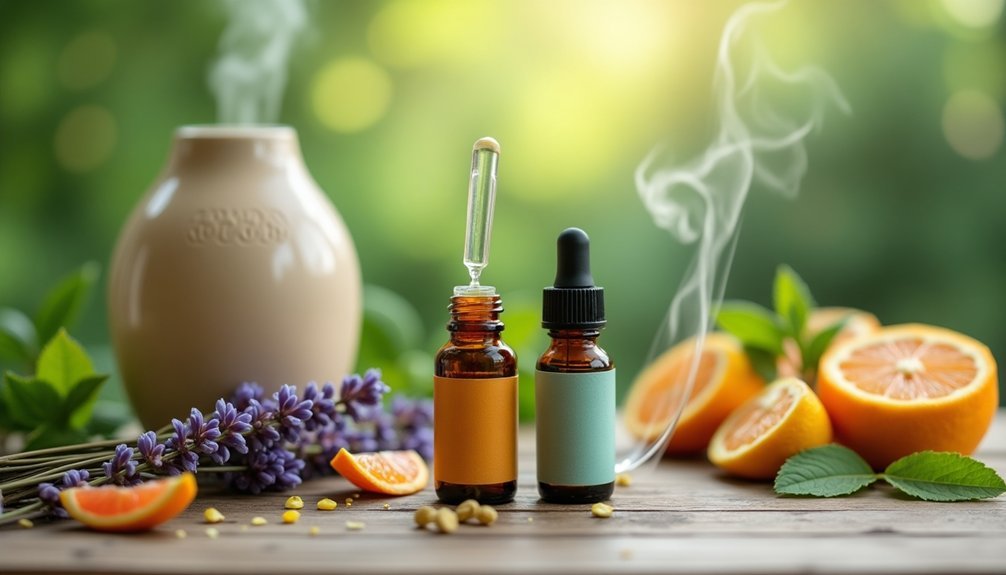To create therapeutic aromatherapy perfumes at home, you'll need to understand essential oil notes and their properties. Start by gathering dark glass bottles, droppers, and a digital scale for precise measurements. Follow the 30-50-20 ratio when blending top, middle, and base notes, and always dilute with carrier oils at 5-10% concentration. Document your recipes and conduct patch tests before use. Exploring the art of therapeutic blending will reveal endless possibilities for your wellness journey.
Understanding Essential Oil Notes and Their Therapeutic Properties

When creating aromatherapy perfumes at home, understanding essential oil notes is crucial for both fragrance composition and therapeutic benefits.
You'll find that top notes, like citrus oils, provide the initial burst of fragrance and offer invigorating properties. They evaporate quickly but can boost your mood and aid digestion.
Middle notes, such as lavender and rose, form the heart of your blend. They last several hours and deliver calming, soothing effects that support emotional well-being.
Base notes, including sandalwood and patchouli, anchor your perfume with their long-lasting presence while providing grounding properties.
To create an effective blend, you'll need to balance these notes while considering their therapeutic actions. Carefully review therapeutic contraindications to ensure all oils in your blend are compatible.
Remember to document your successful combinations and verify all oils work together safely and harmoniously.
Gathering Your Natural Perfume Making Tools and Materials
Before diving into natural perfume creation, you'll need to assemble the right tools and materials for precise, contamination-free blending.
Start with a digital scale that measures to 0.01g and gather essential glass tools like pipettes, droppers, and small beakers for accurate measurements. Use disposable pipettes to avoid any cross-contamination between different scent materials.
You'll need amber glass bottles to protect your essential oils and finished blends from light damage, along with proper labels to track your creations.
Set up a well-ventilated workspace with a dedicated record book to document your recipes. Don't forget coffee grounds or a wool scarf to clear your nose between scent testing.
For your base materials, stock up on perfumer's alcohol or jojoba oil, plus your chosen essential oils and absolutes.
Keep separate equipment to prevent cross-contamination and maintain clean-up supplies nearby.
Mastering the Art of Blending Therapeutic Oil Combinations

Successful therapeutic oil blending requires understanding the delicate interplay between base, middle, and top notes.
You'll want to follow the 30-50-20 ratio: 30% base notes like sandalwood, 50% middle notes like lavender, and 20% top notes like peppermint for a balanced blend. Proper scent pairing ensures the blend creates a harmonious healing effect.
- Start with a small batch of 6-12 drops to test your combination, and hold the selected oil bottles together under your nose to preview the scent.
- Choose oils that align with your therapeutic goals while avoiding contradictory properties, like using energizing peppermint in a sleep blend.
- Document every blend in a notebook, including specific oils, quantities, and vendors, so you can replicate successful combinations.
- Test for safety and compatibility between oils, and always respect dermal maximums when creating topical blends.
Creating Safe and Balanced Aromatherapy Perfume Formulas
Creating safe aromatherapy perfumes requires mastering both the art of blending and the science of safety protocols.
You'll need to understand the three-note system, using ratios like 3:2:1 or 4:2:1 for top, middle, and base notes while tracking each drop in your notebook for consistency.
Always dilute your essential oils with carrier oils at a 5-10% concentration to protect your skin. Before applying any new blend, conduct a 24-hour patch test on your inner wrist.
If you're working with sensitive skin, choose hypoallergenic options like Sandalwood or Sugandh Kokila, and avoid irritating oils such as cinnamon or clove.
Remember that perfumes interact differently with each person's body chemistry, so you'll need to adjust your formulas accordingly.
Follow IFRA Standards to guarantee your blends meet global safety requirements.
Storing and Using Your Handcrafted Wellness Perfumes

Proper storage plays an essential role in preserving your handcrafted wellness perfumes' potency and therapeutic properties. To maintain their effectiveness, you'll need to protect your blends from light, heat, and humidity that can degrade their quality.
- Store your perfumes in dark glass bottles sized for your blend quantity, minimizing air exposure and oxidation.
- Keep your blends in a cool, dry place away from sunlight and heat sources – consider using the refrigerator.
- Label each bottle with the creation date, blend name, and ingredients to track shelf life and enable recreation.
- Gently shake your natural perfumes before use, and let new blends rest for 24 hours to allow scents to meld.
Remember to keep bottles tightly sealed when not in use and transfer oils to smaller containers if you're not using the full amount.
Frequently Asked Questions
Can Aromatherapy Perfumes Trigger Allergies in People With Sensitivity to Fragrances?
Yes, if you're sensitive to fragrances, aromatherapy perfumes can trigger allergies. You'll likely experience skin irritation, respiratory issues, or eye discomfort due to both natural and synthetic chemicals in these scents.
How Long Does a Natural Aromatherapy Perfume Typically Last on Skin?
You'll notice natural aromatherapy perfumes typically last 2-6 hours on your skin. For longer wear, apply to moisturized skin and pulse points, and consider using base notes like sandalwood or patchouli.
Are Aromatherapy Perfumes Safe to Use During Pregnancy?
You'll need to be cautious with aromatherapy perfumes during pregnancy. Stick to safe oils like lavender and lemon balm, avoid risky ones like rosemary and clary sage, and always consult your healthcare provider first.
Can I Wear Aromatherapy Perfumes to Work Without Affecting Colleagues?
You shouldn't wear aromatherapy perfumes to work, as they can trigger health issues in sensitive colleagues. Even natural fragrances can cause asthma, headaches, and breathing problems in your coworkers.
Do Aromatherapy Perfumes Interact With Prescription Medications When Applied to Skin?
Yes, essential oils in aromatherapy perfumes can interact with your medications when applied to skin. You'll need to check with your doctor about specific oils that might affect your prescriptions through skin absorption.
In Summary
You're now equipped to create therapeutic aromatherapy perfumes that support your wellbeing. Remember to always test new blends on your skin, keep detailed notes of successful formulas, and store your creations properly in dark glass bottles. With practice and patience, you'll develop a keen nose for combining essential oils that both smell beautiful and offer targeted healing benefits. Start blending and enjoy your aromatic wellness journey.





Leave a Reply